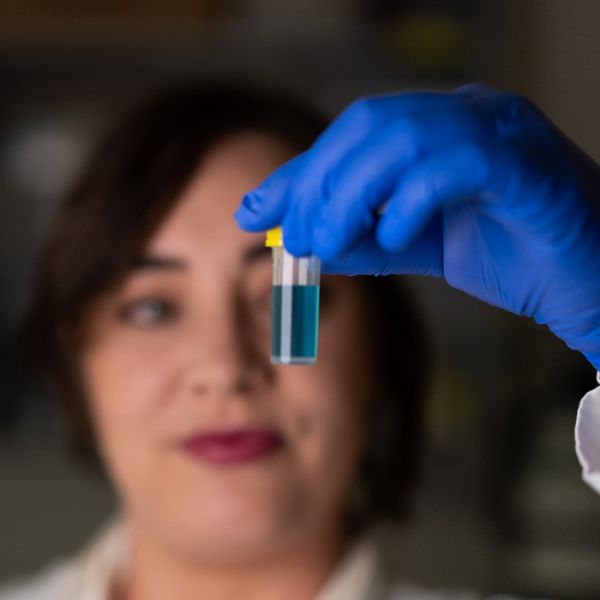Amid the bustle of a sprawling fruit market, health-conscious shoppers eagerly flocked for the best picks of the bunch.
Professor Ravi Naidu and fellow scientists wove through the fruit-stacked aisles. But they weren’t hunting for the freshest greens – they were searching for something far more insidious: an invisible threat in the produce we trust and eat.
Back in their University of Newcastle lab, Ravi’s team tested 53 samples of fruit and vegetables collected from produce markets and retailers.
Their fears were confirmed.
Traces of PFAS – a class of synthetic chemicals known as “forever chemicals” for their inability to break down in the environment – were detected in nine of the samples.
 PFAS contamination in food is just one aspect of a global problem. Used in everything from firefighting foams to non-stick cookware, synthetic carpets and even some types of clothing, these chemicals have seeped into waterways, soils, and ultimately our food chain.
PFAS contamination in food is just one aspect of a global problem. Used in everything from firefighting foams to non-stick cookware, synthetic carpets and even some types of clothing, these chemicals have seeped into waterways, soils, and ultimately our food chain.
Ravi, a Distinguished Laureate Professor and the Director of the University’s Global Centre for Environmental Remediation (GCER), says PFAS can persist in the food chain.
“The problem with growing fruit and vegetables in contaminated soil is that these plants can bioaccumulate,” he says.
“Even if the concentrations of PFAS in soil are very low, plants can absorb and store PFAS faster than they can eliminate it.”
Research has confirmed PFAS can accumulate in humans too – with peer-reviewed studies finding it in blood, liver, lungs, kidneys, brain, and breast milk.
“We know that PFAS can bind to proteins and accumulate in organs. This could increase risk of infertility, cancer and other chronic diseases,” Ravi says.
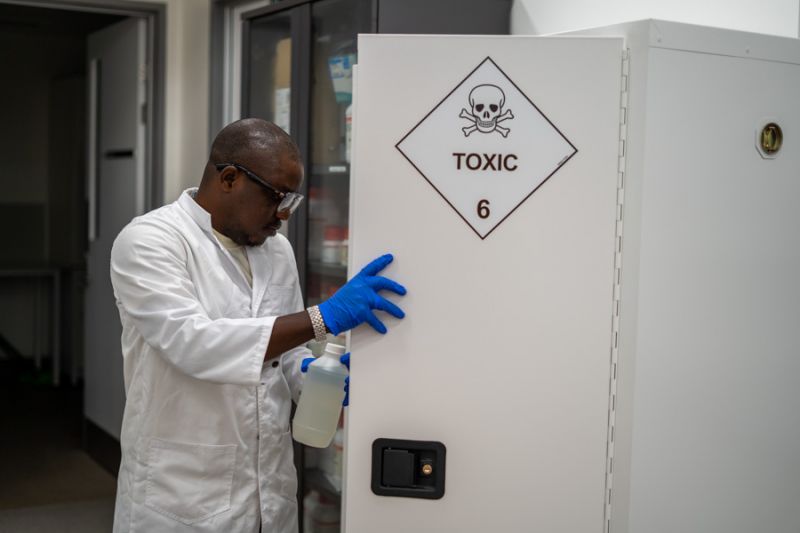
From soil to sperm: uncovering the biological impact
Mounting evidence suggests PFAS may pose risks to human health, including impacts on male fertility.
Recent research from fellow University of Newcastle scientists Professor Brett Nixon and Dr Jacinta Martin is revealing just how those fertility impacts might occur. Their pre-clinical study, published in Communications Biology, exposed animals to PFAS-contaminated water at levels matching those found in the Williamtown contamination zone. While the sperm appeared normal under a microscope, molecular changes suggested altered gene regulation that could disrupt embryo development and influence the health of future generations.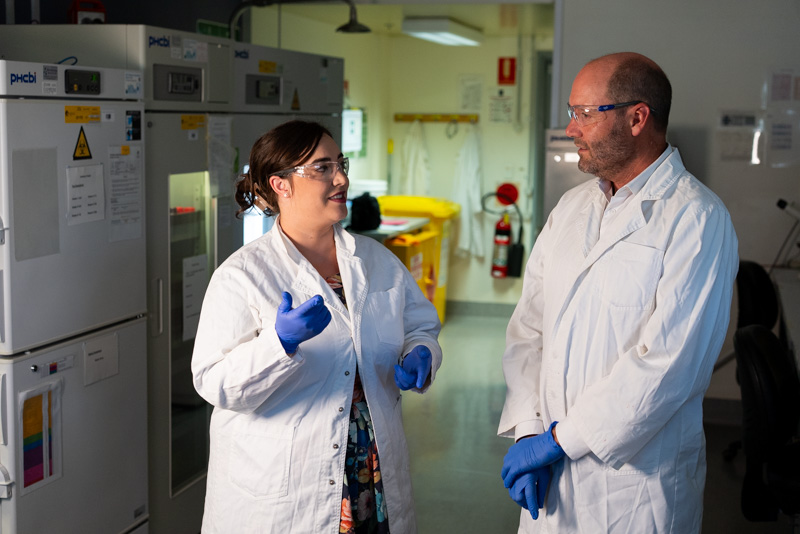
Brett says the findings highlight how subtle but significant the effects of PFAS exposure can be.
“What’s striking is that the sperm still looked and behaved normally,” he says. “But beneath the surface, they were carrying molecular changes that could have consequences for the next generation.”
The team also found reduced testosterone levels and daily sperm production in animal models, indicating that even low, environmentally relevant exposure can have measurable biological effects.
“It’s easy to think of PFAS contamination as an environmental issue,” Jacinta says.
“But our work shows it’s also a health one — it emphasises the urgent need to understand how PFAS exposure affects reproductive health and future generations."
"It emphasises the urgent need to understand how PFAS exposure affects reproductive health and future generations." - Dr Jacinta Martin
Together, their work and Ravi’s environmental research paint a fuller picture of the PFAS problem – from how these persistent chemicals enter our food chain and water to how they may influence reproduction and long-term health.
Identifying PFAS: A complex chemical puzzle
With more than 1,000,000 PFAS-contaminated sites estimated across the world, Ravi says a huge challenge is simply identifying where these chemicals are hiding.
“There is no easy and efficient way to test for PFAS,” he says.
PFAS is an umbrella term, covering anywhere between 400 and 10,000 different compounds, all characterised by the carbon-fluorine bond – one of the strongest known in chemistry.
"There is no easy and efficient way to test for PFAS." - Professor Ravi Naidu
“At best, we can test and identify 29 – 45 different types of PFAS.”
Complicating matters, any equipment designed to test for PFAS must be made from PFAS-free materials to avoid false positive detections.
“It’s very complex, expensive and labour-intensive to measure PFAS in soil, sediment, plants and water,” Ravi says.
Ravi believes a more realistic approach is to work backwards, tracing contamination back to likely culprits.
“First we need to consider, what are the sources of PFAS?” Ravi says.
In the case of the contaminated fruit and vegetables, producers and vendors are likely unaware themselves that their produce contains PFAS.
“Some pesticides and alternative fertilisers such as biosolids contain PFAS so there is likely to be traces of contamination in soils where these have been used,” Ravi says.
A type of firefighting foam known as aqueous film-forming foam (AFFF), containing PFAS, was introduced in the 1970s to extinguish liquid fuel fires. It was, and still is in some countries, used by firefighters and military across the world.
“Firefighting training areas and airports, for instance, could potentially have contaminated sites. So, we need to think about soil or waterways that contamination could have leached into,” Ravi says.
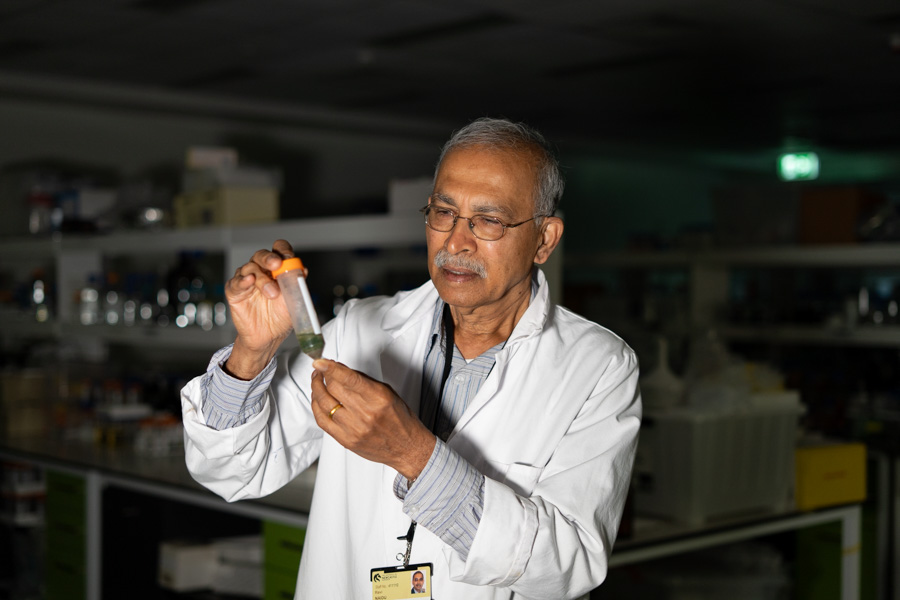
During an NSW Government inquiry into PFAS in waterways and drinking water, Ravi shared a sobering example from his own lab.
“When scientists in my team start working on PFAS remediation, they are first tested for PFAS.
“There was one case of an individual with high levels of PFAS in their bloodstream.
“He was using non-stick utensils at the time. Clearly, that was the source. We said, ‘No more of that,’ and his levels gradually started to decline.
“The source could be water; it could be food that you're eating; what you wear; even the air inside your house,” he added.
"The duration of exposure becomes very important," Ravi revealed.
How can you reduce exposure to PFAS?
- Replace PFAS-coated non-stick cookware that is cracked or chipped with safer alternatives like stainless steel, cast iron or ceramic
- Store leftover food in glass or PFAS-free containers
- Limit intake of foods that come in grease-resistant packaging like popcorn and pizza
- Choose filtered water over tap water
- Avoid microwaving plastic
- Check the ingredients on products and watch for chemical names containing “fluor-”
- Pay attention to what’s in your cosmetics and skincare products
- Be aware of fabric, furniture and carpet labelled ‘stain-resistant’ or ‘water-resistant’
An unbreakable bond? How we’re tackling PFAS decontamination
Detecting PFAS is only the first step – the bigger challenge is finding ways to remove these persistent chemicals. Resistant to natural breakdown, PFAS demand complex solutions, making decontamination the real frontier in tackling their impact.
Ravi, who is world-renowned in his field, has inspired a new generation of innovators in the fight against PFAS. One of them is a University of Newcastle PhD student, Olalekan Simon Awoyemi.
After completing a chemical engineering degree in his home country, Nigeria, Simon pursued master’s degrees in Belgium, focusing on environmental science and contaminated soil.
Living in Europe at the time, he came across Professor Naidu’s pioneering research through Dr Cheng Fang, a senior researcher at the university.
“I’d read about Professor Naidu, so when I saw the ad online for a role in his team, I was eager to apply,” Simon says.
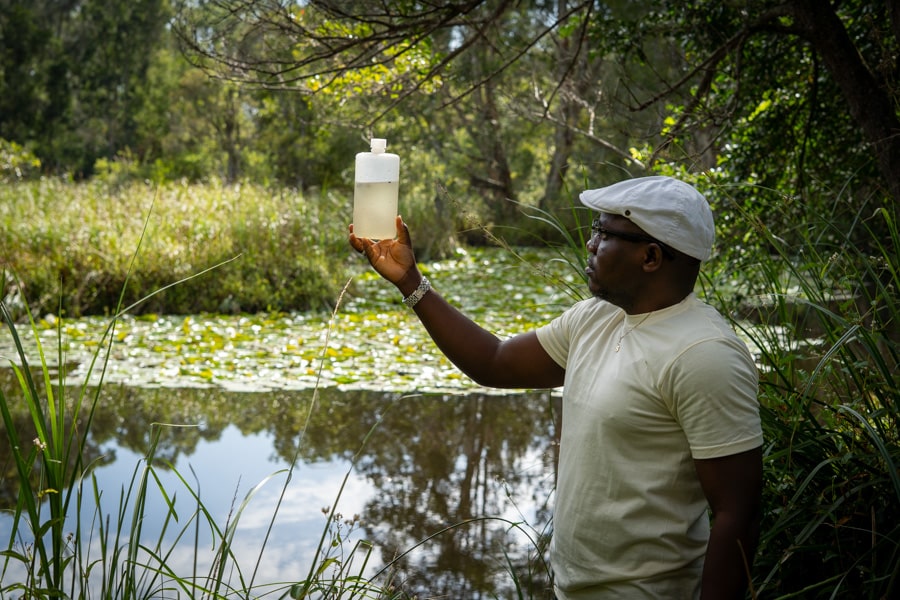
Simon pictured inspecting a water sample at the University of Newcastle
Simon was intrigued by the carbon-fluorine bond that characterises PFAS. It’s the strongest bond in organic chemistry.
It’s this super bond which makes PFAS incredibly difficult to break down, so it persists in the environment for hundreds or even thousands of years.
Can it be broken?
“While there are effective ways to remove PFAS from soil or water, these methods filter out the chemicals but don’t actually destroy them,” Simon explains.
One of those methods is foam fractionation, which removes PFAS from contaminated wastewater, groundwater, or liquid that seeps from landfills. Air is bubbled through the contaminated water, causing PFAS to accumulate at the surface of the bubbles and concentrate in the foam that can be separated and treated.
“The PFAS-rich form then needs to be stored at hazardous waste management facilities where further treatment or safe destruction is required,” Simon explains.
So, he set out to go a step further in his PhD project.
From containment to destruction
Simon decided to combine foam fractionation to separate PFAS, with ultrasound to actually destroy it.
“When ultrasound waves pass through the liquid, tiny bubbles form,” Simon explains.
The bubbles grow and then suddenly collapse.
“When that happens, the collapse creates incredibly high heat - hotter than 4,700 °C. And a huge amount of pressure - about 1,000 times normal air pressure,” Simon says.
These extreme conditions can break apart PFAS chemicals and split water molecules.
“During this process, highly reactive particles called hydroxyl radicals form that help destroy PFAS even further,” Simon says.
By combining the two techniques – separation and destruction – Simon’s study achieved a 97 per cent breakdown of PFAS in the PFAS-rich foam. It was the first to propose this unique hybrid technique.
"It's a breakthrough in the way PFAS contamination is approached," - Professor Ravi Naidu
“It’s a breakthrough in the way PFAS contamination is approached. It has the potential to address a wide range of chemical pollutants in the future,” Ravi says, who supervised Simon’s PhD project.
The new method opens the door to broader applications, with potential to scale up the technology to help remediate PFAS-contaminated wastewater.
There’s hope that in the future it could even be used to treat tap water.
“In Sydney, for example, PFAS has been detected in the drinking water. We could integrate ultrasonication into existing treatment processes so that we end up with water that’s free of PFAS,” Ravi says.
This is just one of the many examples of how scientists at the University of Newcastle are making headway in PFAS remediation.

Foam fractionation separates PFAS by using rising air bubbles

Simon is investigating new techniques to destroy PFAS. Pictured in a University of Newcastle lab

The team uses specialised equipment to test for PFAS levels in samples

Simon is a PhD student with the University's Global Centre for Environmental Remediation
Local research shaping global policy
Ravi and his team started investigating PFAS in 2005. At that time, knowledge was very limited.
Realising that Australia had nearly 200,000 potentially contaminated sites, Ravi was eager to shed light on the little-known issue of PFAS contamination.
By 2007, Ravi had developed technology to treat PFAS in wastewater. Two years later this technology began operating on sites that had large volumes of PFAS-contaminated wastewater.
In 2015, the University opened its Global Centre for Environmental Remediation (GCER), with Ravi as Director. The Centre is focused on developing innovative technologies that help sustain soil health, remediate environmental contamination and prevent contamination.
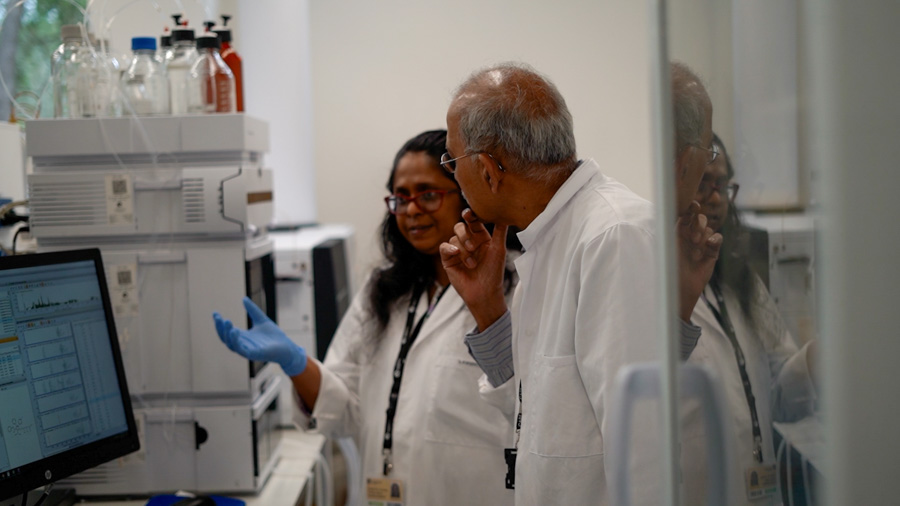
Laureate Professor Ravi Naidu with fellow researcher in the Global Centre for Environmental Remediation, PhD student Yoshida Lakshani Pulippu Widana
Beyond the lab, Ravi’s work has informed government policies and regulations in Australia.
“When we talk about policy, these need to be underpinned by sound science,” Ravi says.
Australia was an early adopter of policies to regulate PFAS. In 2018, a PFAS National Environment Management Plan was established, which Ravi played an instrumental role in initiating.
In the past 70 years, less than ten per cent of sites identified as contaminated in Australia have been remediated.
“The costs have exceeded hundreds of millions of dollars,” Ravi says.
“PFAS contaminated sites bring new challenges as we do not have remediation technologies that break down PFAS to non-toxic products,” he says.
But Australia is well ahead of the game.
Ravi, who is also Chair of the UN FAO’s International Network on Soil Pollution (INSOP) advocates for greater global collaboration.
“Australia can play a very significant role in helping developing countries shape policy,” he says.
Born in Fiji, Ravi is passionate about capacity building particularly in the South Pacific.
“I’d like to see an umbrella legislation for the region, working with them so they know what threshold levels should be and how to minimise,” he says.
“For me, sustainability in our environment is so important because it impacts humanity in the long term” Ravi says.
“We are dealing with more than 10,000,000 potentially contaminated sites worldwide. In the last 75 years, we have remediated less than five per cent of those sites. We still have a long way to go.
PFAS contamination is a challenging environmental problem that demands innovation.
"As a scientist, I love to innovate," - Professor Ravi Naidu
Persistence meets persistence
PFAS has shown how deeply chemicals can permeate our world, but it has also sparked innovation.
The same persistence that makes PFAS so difficult to break down is being matched by University of Newcastle scientists, who are determined to find solutions.
In just a generation, we have moved from barely recognising PFAS to developing real strategies for its removal.
“Awareness is the first step in remediation. And we’ve thankfully already climbed that hill,” Ravi says.
Yet the journey is far from over.
With new technologies, improved understanding of health impacts, and the next generation of researchers rising to the challenge, there’s hope.
“The problem may be persistent, but so is the science rising to meet it,” Ravi says.
